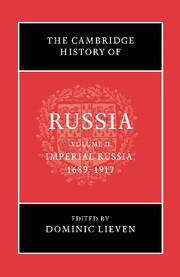Book contents
- Frontmatter
- Introduction
- Part I Empire
- Part II Culture, Ideas, Identities
- Part III Non-Russian Nationalities
- Part IV Russian Society, Law and Economy
- 11 The elites
- 12 The groups between: raznochintsy, intelligentsia, professionals
- 13 Nizhnii Novgorod in the nineteenth century: portrait of a city
- 14 Russian Orthodoxy: Church, people and politics in Imperial Russia
- 15 Women, the family and public life
- 16 Gender and the legal order in Imperial Russia
- 17 Law, the judicial system and the legal profession
- 18 Peasants and agriculture
- 19 The Russian economy and banking system
- Part V Government
- Part VI Foreign Policy and the Armed Forces
- Part VII Reform, War and Revolution
- Bibliography
- Index
- Map 5. The Russian Empire (1913). From Archie Brown, Michael Kaser, and G. S. Smith (eds.) Cambridge Encyclopedia of Russia 1982.">
- Plate Section">
- References
16 - Gender and the legal order in Imperial Russia
from Part IV - Russian Society, Law and Economy
Published online by Cambridge University Press: 28 March 2008
- Frontmatter
- Introduction
- Part I Empire
- Part II Culture, Ideas, Identities
- Part III Non-Russian Nationalities
- Part IV Russian Society, Law and Economy
- 11 The elites
- 12 The groups between: raznochintsy, intelligentsia, professionals
- 13 Nizhnii Novgorod in the nineteenth century: portrait of a city
- 14 Russian Orthodoxy: Church, people and politics in Imperial Russia
- 15 Women, the family and public life
- 16 Gender and the legal order in Imperial Russia
- 17 Law, the judicial system and the legal profession
- 18 Peasants and agriculture
- 19 The Russian economy and banking system
- Part V Government
- Part VI Foreign Policy and the Armed Forces
- Part VII Reform, War and Revolution
- Bibliography
- Index
- Map 5. The Russian Empire (1913). From Archie Brown, Michael Kaser, and G. S. Smith (eds.) Cambridge Encyclopedia of Russia 1982.">
- Plate Section">
- References
Summary
This Chapter will explore a single but significant dimension of women’s experience in Imperial Russia: the transformation of their legal status from the Petrine reforms to the eve of the 1917 Revolution. It has become a truism among scholars that law codes both mirror and produce gender difference and hierarchies. In this regard, Russian legal culture proved no exception: normative law drew marked distinctions between women and men, as well as distinguishing between individuals on the basis of social standing. When applied to women, the juridical system in Imperial Russia was also noteworthy for tensions and inconsistencies that intensified with the elaboration of women’s status in written law. This essay will investigate the origins of competing definitions of gender in the realms of property, family and criminal law. In the pre-reform era, the clarification of women’s civil status elevated noblewomen’s standing in the patriarchal family by extending their rights over property, yet simultaneously institutionalised their subordination to their husbands. The legal regime that emerged after the Great Reforms of the 1860s placed a novel emphasis on female vulnerability and the assignment of women to the domestic sphere, at the very moment that unprecedented numbers of peasant women were making their way into the urban marketplace. As I will argue in the following pages, if the legal order in eighteenth-century Russia minimised sexual difference in many respects, nineteenth-century innovations in the law highlighted gender distinctions to an unprecedented degree.
- Type
- Chapter
- Information
- The Cambridge History of Russia , pp. 326 - 343Publisher: Cambridge University PressPrint publication year: 2006
References
- 15
- Cited by

